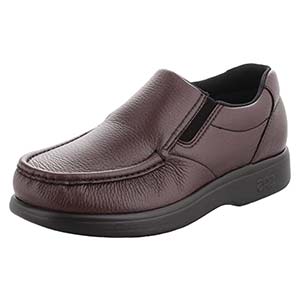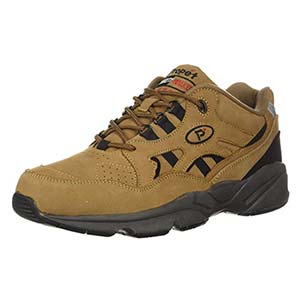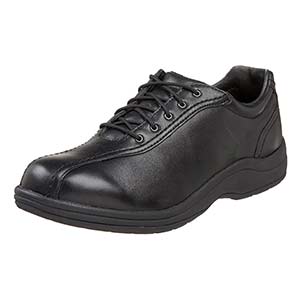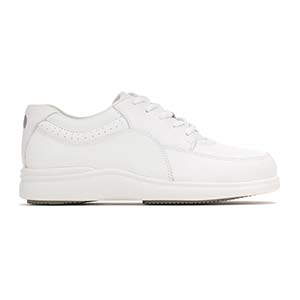Finding the Best Shoes for Diabetic Neuropathy can transform daily comfort and dramatically reduce the risk of ulcers, blisters, and falls for people with diabetic neuropathy. The best options combine generous toe room, removable insoles, shock-absorbing cushioning, and a stable sole to redistribute pressure and protect sensitive feet.
In this guide, you’ll discover trusted, podiatrist-recommended features and practical buying tips to help you choose shoes that relieve pain, prevent injury, and keep you confidently active. Ready to find the perfect fit for safer, more comfortable steps?
What is Diabetic Neuropathy?
Diabetic neuropathy is one of the complications of diabetes, which pertains to damage to the nerves that can be pretty painful. Among the body areas that are usually affected by this condition are the legs and feet. When nerve damage occurs in the feet, this can lead to a loss of sensation that may develop into serious foot problems. In addition, since there is numbness in your feet, some people can remain unaware of any existing injuries, cuts, blisters, or thickened calluses on this part of their body until the issue becomes worse.
Several symptoms are linked with diabetic neuropathy, including pain, burning sensation, numbness, and tingling in the feet. These symptoms may become less severe in most instances once your blood sugar is maintained within normal levels. Moreover, your doctor may prescribe certain medications that can help ease discomfort and pain.
However, if you fail to practice proper foot care and continue to wear inappropriate shoes, you may eventually develop foot ulcers. This condition can cause severe pain and may even lead to amputation once the open wound becomes infected.
What are The Best Shoes for Diabetic Neuropathy – What to Look For
Diabetic shoes are much broader and deeper than your average footwear because these are intended to reduce the risk of skin ulcers, particularly among people who suffer from foot disease. With additional width and depth, your feet can move freely without brushing against the interiors of the shoes. In addition, there are no seams on the insides, as these tend to rub against the feet and cause discomfort.
Shoes designed for people with diabetes have rocket soles, which minimize pressure on the foot while providing more excellent stability. Hence, there are fewer risks of stumbling or twisting your ankle as you walk. Firm heel counters also offer ample support and enhance your balance with every step you take.
Generally, the perfect shoes for neuropathy are prescribed by trained podiatrists. These specialists can recommend shoes to help lessen the impact, stress, and pressure on your feet.
5 Best Shoes for Diabetic Neuropathy – Reviews
The following are some brands of diabetic shoes that come with soft linings and provide excellent support. These products also have cushioned soles that lessen the impact on your feet to reduce stress and pressure. Learn more about these footwear brands and their key features.
1. SAS Men’s, Side Gore Loafer
If you need ample arch support and balance with every stride, then these shoes are for you. The footwear is also available in medium, wide, and extra-wide, so you can choose the correct width that suits you best. With excellent fit, durable and firm soles, and superior back support, these shoes are indeed the right choice for people who suffer from foot problems. What’s more, these shoes look pretty stylish, so you can look fashionable without sacrificing your comfort.
2. Propét Men’s Stability Walker Medicare – Code = A5500 Diabetic Shoe Sneaker
Do you experience numbness or a burning sensation in your feet? Make the right choice by purchasing the best type of shoes designed specifically for people with diabetes. This comfortable and lightweight footwear offers good traction, ensures your stability, and enhances ankle support with its padded collar design. This product also has a molded EVA midsole, which adds to the shock-absorbing property of the shoes. Available in a range of colors, sizes, and widths, you can find the right shoes that are made precisely to meet your needs.
3. P.W. Minor Men’s Leisure Time Dx2 Strap Shoe
These shoes are known for their spacious toe box, which keeps your feet comfortable. With excellent support and protection from impact, the footwear can significantly minimize stress or pressure on your feet. Even if you have to wear these shoes for hours, your feet can stay dry and cool because of the breathable material used in the footwear’s interior. Lastly, the soft and lightweight sole made of polyurethane material allows you to move with ease and comfort at all times.
4. P.W. Minor Women’s Central Park Lace-Up
Look sharp and feel good at the same time while you step in style with these shoes by P.W. Minor. The footwear is designed for people with diabetes, and the footwear comes with a spacious toe box, deep profile, and a well-supportive arch for your ultimate comfort. If you prefer to place your custom-made orthotics, you can remove the cushioned footbed in these shoes. These shoes reduce any impact or pressure on your feet with superb protection and support on the heel and the metatarsal region.
5. Hush Puppies Women’s Power Walker Sneaker
Bask in the excellent support that these Power Walker shoes by Hush Puppies offer. Made of top-quality leather, you can be sure that the footwear will last for several years. Furthermore, it comes with adjustable straps that enhance support and comfort without restricting your foot. You will also appreciate the moisture-wicking property and cushioning features of the shoe, so you can stay at ease, walk steadily, and experience total satisfaction each time you walk.
How to Help: Shoes for Diabetic Neuropathy
Living with diabetic neuropathy changes how feet feel, how they respond to pressure, and how quickly small problems can become serious. Choosing and using the right shoes is one of the simplest, most effective ways to protect your feet, reduce pain, and prevent ulcers or infections. This article explains why shoes matter, how therapeutic footwear helps, how to choose the right pair, simple care tips, and when to seek professional help.
Why proper shoes matter for diabetic neuropathy
- Diabetic neuropathy reduces sensation and alters foot shape and gait, increasing the risk of blisters, pressure sores, and unnoticed injuries. Protective footwear reduces repetitive pressure, cushions vulnerable areas, and lowers the chance of complications that can lead to infection or amputation.
- Supportive, well-fitting shoes also improve balance and walking comfort, helping you stay active safely and maintain better overall foot health.
How shoes help (mechanisms and benefits)
- Pressure redistribution: Cushioned insoles and shaped footbeds spread load across the sole to prevent focal pressure points that cause ulcers.
- Shock absorption: Thick, compliant midsoles reduce impact when walking, easing pain from neuropathic and joint-related discomfort.
- Protection from external injury: Closed-toe, seamless uppers and roomy toe boxes prevent rubbing, reduce friction, and protect against foreign objects or accidental knocks.
- Stability and support: Firm heel counters and appropriate arch support reduce abnormal foot motion that can create shear forces and skin breakdown.
How to choose shoes for diabetic neuropathy
Use this step-by-step checklist when shopping or evaluating footwear.
- Fit and volume
- Roomy toe box: Ensure toes lie flat without crowding; you should have about a thumb’s width from the longest toe to the end of the shoe.
- Wide and deep last: A shoe with extra volume avoids compression of deformities or areas of high risk.
- Construction and features
- Seamless, soft uppers to reduce friction and hotspots.
- Removable insoles to accommodate custom orthotics or accommodative inserts.
- Firm heel counter for stability and to limit excessive rearfoot motion.
- Non-slip outsole with moderate tread to improve traction and reduce fall risk.
- Cushioning and support
- Choose moderate to high cushioning in the midsole for shock absorption, but avoid overly soft shoes that compromise stability.
- Consider shoes marketed as diabetic, neuropathy-friendly, or therapeutic—these often combine protective features and room for orthoses.
- When to consider custom or prescription footwear
- If you have foot deformities (hammer toes, Charcot foot), recurring ulcers, or significant gait changes, custom orthoses or prescription shoes from a podiatrist or certified pedorthist may be necessary.
- Try before you buy
- Shop in the afternoon (feet swell during the day), bring any orthotics you use, and walk 10–15 minutes in the shoes to detect rubbing or instability before purchase.
Daily care, modifications, and maintenance
- Inspect feet daily for redness, blisters, cuts, or swelling; check inside shoes for foreign objects before wearing.
- Rotate shoes to allow materials to recover and reduce moisture buildup.
- Use cushioned, moisture-wicking socks with no seams; avoid tight elastic tops.
- Replace shoes when midsole cushioning compresses or the outsole wears unevenly—replace sooner if you notice new hotspots or pain.
- Orthotics and protective pads: Consider over-the-counter cushioned insoles initially; consult a specialist for custom orthotics if problems persist.
When to see a professional
- Seek podiatry or medical care promptly for persistent redness, open sores, draining wounds, increasing pain, or signs of infection (heat, spreading redness, fever).
- Ask a podiatrist or orthotist about custom footwear if you have recurrent ulcers, significant deformity, or need specialized offloading devices.
Quick product guidance and practical tips
- Look for brands and models reviewed for diabetic neuropathy that emphasize roomy fit, removable insoles, cushioning, and seamless uppers.
- Avoid tight, narrow, or high-heeled shoes and any footwear with internal seams that rub sensitive skin.
- Keep blood sugar well controlled and maintain regular foot checks—shoe choice reduces risk but does not eliminate it.
Short FAQ
- Which is more important: cushioning or stability?
- Both matter; adequate cushioning reduces pressure while stability prevents abnormal motion that can cause shear injury. Aim for a balance rather than extreme softness or stiffness.
- Can regular athletic shoes work?
- Some athletic shoes meet neuropathy needs if they’re roomy, have removable insoles, good cushioning, and no internal seams; evaluate them against the checklist above.
- Are diabetic shoes covered by insurance?
- Coverage varies by country and plan; consult your healthcare provider or insurer for local rules and documentation requirements.
Choosing the right shoes is a practical, high-impact step to protect feet with diabetic neuropathy. Focus on fit, protective construction, cushioning with stability, and professional guidance when deformity or wounds exist. With careful selection and daily foot care, you can reduce risk, ease discomfort, and stay active with greater confidence.
Bottom Line
Wearing the wrong shoes can mean painful arches, cramps, and blistered heels that eventually disappear after a few days. However, for people with diabetes, inappropriate footwear can cause serious issues such as infections, sores, and amputation in severe cases. Fortunately, you can avoid all of these problems by consulting a podiatrist and following his recommendations for the correct type of shoes you should wear.
If you have diabetes, make it a point to choose the best footwear for your condition and apply proper foot care techniques prescribed by your doctor. By keeping in mind these practical tips, you can prevent severe problems while ensuring your health and well-being.
References:
http://www.webmd.com/diabetes/diabetes-neuropathy
http://www.medicinenet.com/script/main/art.asp?articlekey=79511






